|
|||||||||
|
NEW SCHOLARSHIP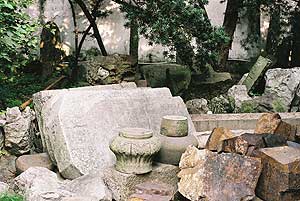 Fig. 1 Jesuit Gravestones in ShanghaiOn a visit to Shanghai in October 2006, I made a journey to the Yuyuan Garden, in the middle of what remains of the old fortified Chinese city. Wandering around the back of the garden, I saw the stones illustrated here behind a pavilion (Figs 1&2). Initially, I was attracted by their shape, as these rectangular blocks of stone seemed unusual in a Chinese garden. The 'IHS' carved in the middle of the top section of the uppermost stone was decidedly out of place in a garden initially built during the Ming dynasty. The emblem, and the inscription below it indicate that this was the tombstone of a Jesuit. 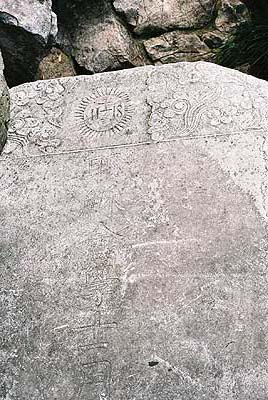 Fig. 2 As far as can be made out, the stone was originally inscribed with Chinese characters on at least two sections. There is the vertical inscription—耶稣会学士周 □□ 公 (Esteemed scholar Zhou □□ of the Society of Jesus)—running down the middle of the stone's front face, and then there are smaller characters in vertical lines on the right hand side of the stone. There appeared to be writing of some sort on the left hand side as well, although this was difficult to make out because of weathering. Cloud or flower motifs (or possibly both) run along both sides of the headstone, finishing at the top, but not touching, separated by IHS. It was not possible to view the reverse of the stone, nor the three other stones that were stacked behind this first stone. They were, however, of the same length and thickness. IHS is the emblem used predominantly by the Jesuits, more formally known as the Society of Jesus, the Catholic religious order of priests and brothers founded by St Ignatius of Loyola in 1540. These three letters are taken to be the first letters of the Greek word for Jesus, although there is much debate about other pre-Christian origins for this symbol. The abbreviated form has been used by the Jesuits since their inception. Generally these letters appear in the middle of a pictorial representation of the sun. The growth of the Society of Jesus in the sixteenth and seventeenth centuries, their missionary activities throughout the world, and their deliberate use of visual imagery quickly saw this emblem become especially associated with them. The letter 'm', shown here in the middle of a heart image, which is itself inscribed into the IHS, arguably refers to pious devotion to the 'immaculate heart of Mary' among Catholics. Although this specific devotion seems to date to the late tenth century, it became especially widespread from the end of the eighteenth century. The devotion is based on the biblical passages that mention the compassion of Mary, and in particular to the references that describe Mary as keeping the words and actions of her son Jesus in her heart (see the Gospel of Luke 2:19:51). Devotion to the immaculate heart of Mary was given added emphasis by the devotions associated with the supposed Marian apparitions to Catherine Labouré, which occurred in Paris in 1830. The nineteenth century in France saw two major Marian events—these apparitions in Paris (which resulted in the devotion to the 'miraculous medal') and the reported apparitions of Mary to Bernadette Soubirous at Lourdes, in the French Pyrenees, in 1858. The Chinese characters on this tombstone clearly indicate that the tomb occupant was surnamed Zhou, that he was a Jesuit and a scholar (xueshi). If he were more specifically a Jesuit scholar, he would have had between ten and fourteen years of training, not counting any further language study, but this is not clear from the monumental inscription. However, he would almost certainly have been ordained. 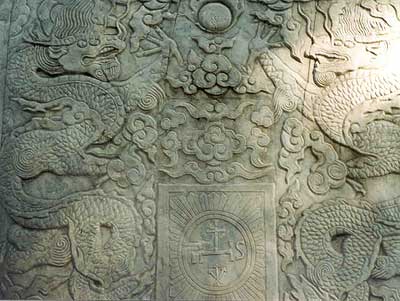 Fig. 3 The Jesuits first arrived in Shanghai in 1608, when the Italian Jesuit Lazzaro Cattaneo established a Christian community there at the invitation of Xu Guangqi. Upon the death of his father, Xu, at that time a corrector in the Hanlin Academy, had returned to his hometown of Shanghai in order to spend the customary three years of mourning. Xu was baptised in 1603 and wanted to be able to receive the sacraments. The Christian history of Shanghai begins from this time. The international demise of the Jesuits in 1773, as a result of their suppression by Pope Clement XIV, also resulted in their disappearance from China. The Society was revived by Pope Pius VII in 1814, although it was not until 1842 that Jesuits first returned to China. The first three Jesuits to return were all Frenchmen, from the Jesuit province of Paris. The city they went to was Shanghai. 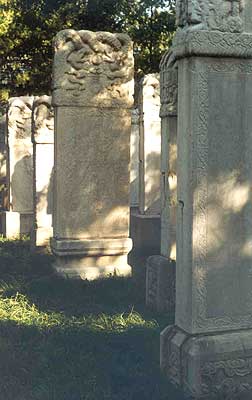 Fig. 4 All this is by way of background in order to be able to hazard a guess at the tombstones' provenance. Later, suggestions will be made about how to identify the Jesuit priest surnamed 'Zhou'. There were numerous missionary cemeteries in China following the Jesuit arrival in the 1580s, with the most famous ones being in Beijing, although there was also a significant Christian burial ground in Hangzhou. The most famous Beijing cemetery was called Zhalan, in the outer suburbs of Beijing (now the Beijing Administrative College at 6 Chegongzhuang Street, Chegongzhuang). This became a cemetery when the Wanli Emperor (r.1573-1620) gave land to the Jesuits so that they could bury their illustrious companion, Matteo Ricci, who had died in May 1610. Other missionaries were buried there as well, and sometimes the tombstones were inscribed with symbols that indicated imperial approval of that particular missionary's work in China, as for instance with Adam Schall von Bell and Ferdinand Verbiest, both of whom were astronomers in the imperial calendrical bureau. Such stones (Figs 3&4) were large and elaborately carved, much more than the stone discovered at Yuyuan. Thus, given that the form of this stone is substantially different from the tombstones at Zhalan (and indeed the tombstones now held at the Stone Carving Museum, in Beijing, which date from the arrival of French Jesuits in the late 1600s), and contain an emblem especially associated with French piety of the nineteenth century, it seems reasonable to suggest that the Yuyuan stones date from the period beginning 1842, when the Jesuits returned to China. In the 1930s, the Catholic church of Shanghai produced a map showing the location of parishes, schools, hospitals and so on. It also indicated that there were several cemeteries in Shanghai where members of the Catholic communities were buried. One of these was located just to the south of the old Chinese city, which was now bordered on its north and its west by the French concession. The section of Shanghai south of the fortified city (Fig. 5) was administered by the local Chinese authorities. The Catholic cemetery located here was known as the Priests' Cemetery (Cimitière des Pères). In the absence of evidence one way or the other, it is not possible to say that the Yuyuan stones come from this cemetery, but the proximity of this plot to Yuyuan is noteworthy all the same. 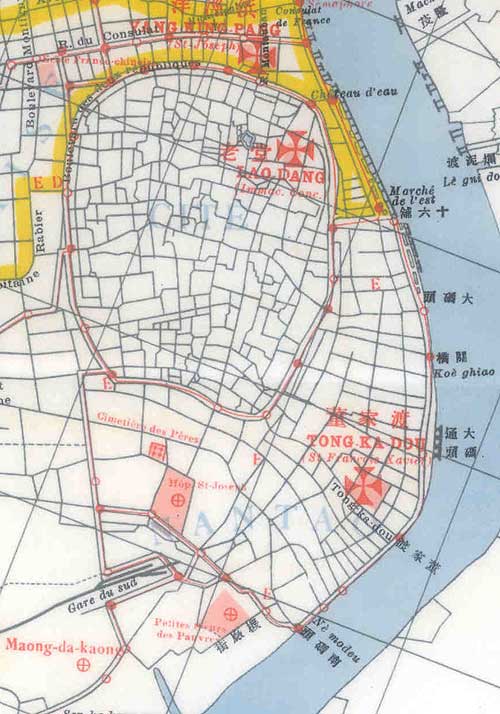 Fig. 5 Section of the map Shanghai Catholique (Catholic Shanghai), printed in1933 at the Tushanwan printery, Xujiahui, showing the Priests' Cemetery in relation to the old fortified city. The key to determining the original location of these stones is the identity of Fr Zhou. This would also be greatly helped by being able to identify the final two characters of Fr Zhou's name, which, as noted, are indistinct. Whereas there exist collections of biographical lists of Jesuit priests and brothers (both foreign and Chinese) who worked in China during the period leading up to the suppression, there do not yet exist systematic, reliable, public lists of Jesuits who worked in China after the Society's return in 1842. Joseph Dehergne's Répetoire des Jésuites des Chine de 1552 à 1800 (List of Jesuits of China from 1552 to 1800), published in 1973 by the Jesuit Historical Institute in Rome, could at least be used to establish that this Fr Zhou was not from the earlier period. Research will still need to be conducted in the various archives of the Society, and in places like the former Jesuit theologate library at Xujiahui (now known as the Zikawei Bibliotheca of the Shanghai Municipal Library), to be able to identify Zhou with any accuracy. Other scholars of Christian history in China might have information that assists in this process. As indicated above, I was unable to view the three other stones behind this one belonging to Fr Zhou, nor make a photographic record of them. Assistance from the relevant local authorities is clearly essential in identifying the men remembered on these stones. At this stage, all that can be said is that an aimless meander through a Shanghai garden has opened up a fruitful line of historical enquiry. [Jeremy Clarke, SJ] |